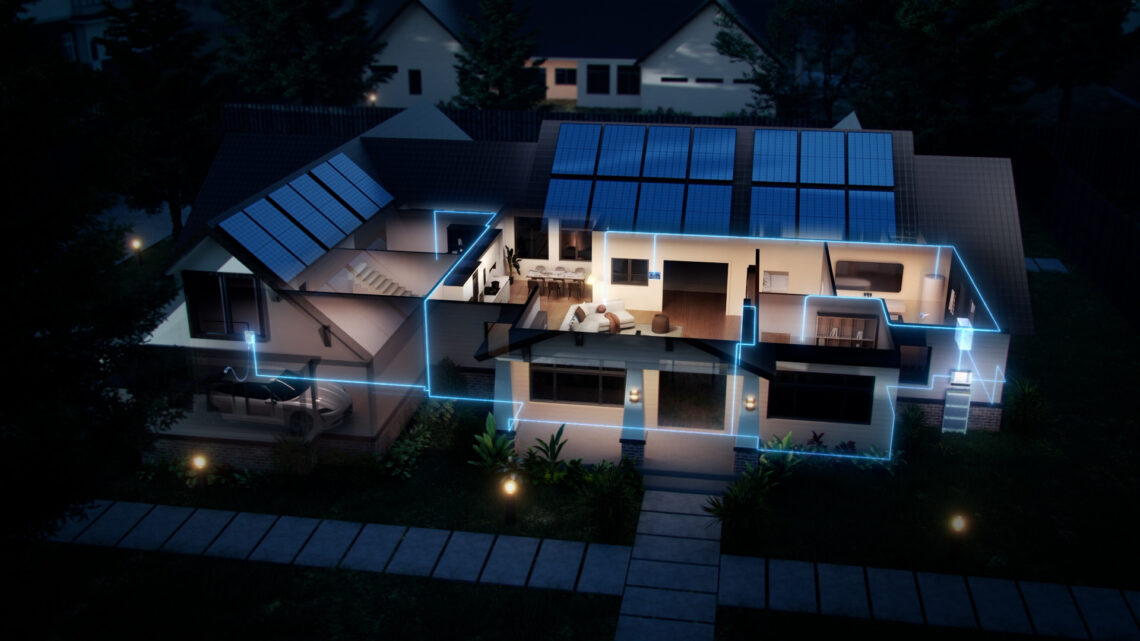Source:(https://ecoflow-service-eu-cdn.ecoflow.com/configurable/images/1751619525030/image3.jpg)
Page Source:(https://homebattery.ecoflow.com/uk/blog/easily-accessible-home-energy-monitor)
Imagine a home that “knows” when to run appliances, charges its battery storage when electricity is cheapest, and powers critical systems when the grid goes down. This is no longer science fiction — it’s the reality of smart home integration with home battery storage. By combining home automation with battery systems, homeowners can save energy, increase resilience, and simplify daily life.
This guide explains why smart home and battery storage integration matters, outlines common challenges, and highlights key technologies for effective implementation. It also offers practical tips for getting started and choosing the right setup, while looking ahead at future trends in smart energy solutions.
Why Smart Home Tech and Battery Storage Matter More
If you’ve noticed your electricity bills creeping up — or experienced the occasional power cut — you’re not alone. Energy prices across the UK have been all over the place lately, and for some areas, power outages are becoming a bit too familiar.
The good news? There’s a smarter way to manage it. Studies suggest that combining solar panels with home battery storage could help households cut their electricity bills by around 15%. Even better, it gives you the ability to keep the lights (and essentials) on when the grid goes down.
Here are some of the common frustrations we hear from homeowners:
- High bills during peak hours or under time-of-use pricing
- Not knowing exactly how or when energy is being used
- Feeling powerless (literally) during grid failures or blackouts
Home battery storage helps address these challenges by storing energy during cheaper off-peak times (or capturing excess solar generation) and discharging it during periods of high demand or higher tariff rates. EcoFlow’s advanced battery solutions integrate seamlessly with smart home systems, enabling automated energy management that maximises savings and ensures power reliability. When combined with EcoFlow technology, homeowners can enjoy optimised energy use without needing to manually control the system.
One example of such a system connects directly to a home’s electrical network, enabling seamless energy optimisation with minimal user input.
How It Works: Core Components & Workflow
Effective smart home and battery storage integration typically includes several key
components that work together:
- Battery & Energy Storage System
Think of this as the command center of the home. The automation hub connects with smart devices—like thermostats, lights, appliances, and even EV chargers—and helps them work together. It decides when to pull power from the battery, when to charge up, and when to stick with grid electricity, using inputs like schedules, sensors, and user preferences.
- Smart Home & Automation Hub
Not all appliances are created equal—especially in a power outage. Load management tools let homeowners prioritize what stays on during limited battery backup, like the fridge, heating/cooling, or medical devices. This can be done through smart plugs or by managing entire circuits directly.
- Load Management & Circuit Control
Not all appliances are created equal—especially in a power outage. Load management tools let homeowners prioritize what stays on during limited battery backup, like the fridge, heating/cooling, or medical devices. This can be done through smart plugs or by managing entire circuits directly.
4. Smarter Energy Decisions with Data
These systems aren’t just reacting—they’re learning. By analyzing past energy use, local weather, and electricity prices, the system can make smarter decisions about when to store or use energy. Advanced predictive algorithms (like model predictive control) have proven to be more efficient than simple rule-based systems—sometimes by more than 10%.
- Connecting to the Grid & Earning Incentives
Depending on where you live, you might be able to sell extra power back to the grid, join a virtual power plant, or take advantage of time-of-use pricing. Rebates, net metering, and other incentives can also help offset the upfront costs and improve long-term savings.
Strategies to Optimise Performance & Savings
Several strategies can help homeowners get the most from a smart home battery
integration:
- Time-of-Use (TOU) Optimisation
Charging the battery during off-peak hours and discharging it during peak pricing can lower electricity bills by 30–50% in favorable locations.
- Prioritise High-Value Loads
Not all appliances need battery backup. Focus on essential systems — like refrigeration, lighting, and internet — during outages to maximise battery life.
- Smart Scheduling and Automation
Use rules such as:
o Delay washing machine or dishwasher cycles until off-peak hours o Pre-heat or pre-cool the home when electricity is cheapest o Shift EV charging to coincide with excess solar or low grid rates Many smart hubs offer “energy” modes focused on cost savings or grid resilience.
- Monitor & Adjust
Regularly review energy usage, battery performance, and cost savings. Adjust thresholds, device schedules, or load priorities based on seasonal or lifestyle changes.
- Account for Efficiency Losses
Battery systems typically incur energy losses of 8–14% due to conversion inefficiencies. Homeowners should factor this into performance expectations and cost analyses.
Challenges & Considerations
While the benefits are clear, there are practical challenges and considerations to address:
- Upfront Cost
Battery systems and automation hubs require a significant investment. However, tax credits, rebates, and financing options can help reduce the burden.
- Lifespan & Maintenance
Most batteries have a lifespan of 10–15 years. It’s important to consider warranty coverage, replacement planning, and ongoing monitoring.
- Compatibility & Interoperability
Not all smart home devices and battery systems communicate effectively. Choosing open-protocol systems or those with robust APIs can future-proof the setup.
- Regulations & Utility Policies
Some utilities restrict grid exports or impose unfavorable rate structures. Local rules should always be reviewed before installation.
- Efficiency Losses
As previously mentioned, battery systems are not 100% efficient, and this can affect the overall financial return if not properly accounted for.
Example Use Case: A Day in the Life of an Automated Home
To illustrate the system in action, consider this simplified daily scenario:
- Midnight to 5am – Battery charges from the grid or taps into late-night solar.
- 6am–9am – Battery discharges to power heating, lighting, and breakfast
appliances during peak demand.
- Midday – Solar panels meet household demand; any surplus energy charges the
battery.
- Afternoon – Minimal battery use; energy is conserved for the evening peak.
- 5pm–9pm – Battery powers evening loads. If depleted, the grid supplements as
needed.
- Overnight – The cycle resets, and the system prepares for the next day.Meanwhile, the smart hub monitors energy prices, weather forecasts, and usage
patterns to dynamically adjust its strategy.
Steps to Get Started
For homeowners considering smart home and battery integration, here is a practical
roadmap:
- Assess the Home’s Energy Profile
o Review hourly usage data
o Understand the current electricity tariff structure
o Evaluate local outage risks
- Select Battery Hardware
o Consider storage capacity, output, and modularity
o Check warranty terms and manufacturer reputation
- Choose an Automation Hub
o Prioritise compatibility with existing smart devices
o Look for strong software, user interface, and support for open protocols
- Design Load Prioritisation
o Identify which circuits or appliances get battery power during outages
o Use smart circuit breakers or load controllers as needed
- Program Automation Rules
o Begin with simple rules (charge off-peak, discharge during peak)
o Gradually implement predictive logic and dynamic thresholds
- Monitor and Iterate
o Analyse energy data regularly
o Refine settings for maximum efficiency and savings
- Track Available Incentives
o Explore local rebates, VPP programs, or tax credits
o Timing installation around incentive availability can improve ROI
Conclusion
The integration of smart home technology with home battery storage gives homeowners a meaningful way to take control of their energy use. It can lead to lower utility bills, greater energy independence, and improved resilience during power outages or high-demand periods.
While there may be initial costs and some complexity involved, thoughtful planning and the right automation tools can make the system both practical and worthwhile.For those considering the shift to smart energy solutions, there are platforms available
to guide them through system compatibility, design, and optimisation. Starting small and making adjustments over time allows any home to gradually become more efficient and self-sufficient.
Smarter energy choices lead to stronger, more resilient homes.





